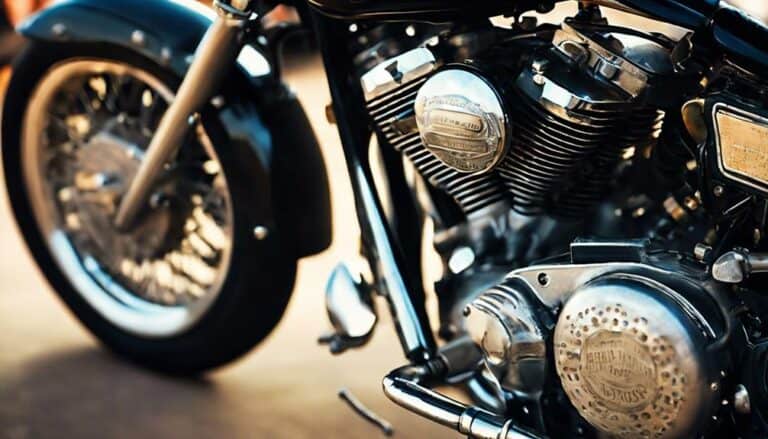You might be surprised to learn that the last year Harley Davidson utilized carburetors was back in 2006, a pivotal moment in the company's engineering history.
This shift marked a significant turning point for Harley enthusiasts, prompting discussions that continue to resonate within the community today.
The move towards fuel injection not only altered the technical landscape of the bikes but also raised questions about the legacy and practicality of carbureted systems in modern Harley models.
Stay tuned to explore the impact of this transition and the ongoing debate surrounding carburetors versus fuel injection in the realm of Harley Davidson motorcycles.
Key Takeaways
- Carburetors were last used by Harley-Davidson in 2006.
- Transition to fuel injection began in 2005, marking the end of carburetor usage.
- TC96 models in 2007 exclusively featured Electronic Fuel Injection (EFI).
- The shift to fuel injection was driven by emission regulations and improved performance.
History of Harley Carburetors
In tracing the evolution of Harley carburetors, one can observe a shift in design and technology over the decades leading up to their eventual discontinuation in the mid-2000s.
Last year, in 2006, Harley-Davidson produced its final carbureted models, likely using the Keihin CVK 40 carburetor. These carburetors had been a staple in Harley-Davidson motorcycles for years, with aftermarket companies also offering various carburetor options for enthusiasts.
However, the era of carburetors came to a close as Harley-Davidson made the transition to fuel injection for improved performance. The shift towards fuel injection began in 2007 and was completed in 2008, marking the end of carburetors across all Harley-Davidson models.
This move allowed for better fuel efficiency, throttle response, and overall engine performance, aligning with the ever-evolving technological advancements in the motorcycle industry. Harley riders embraced this change, recognizing the benefits that fuel injection brought to their riding experience.
Evolution of Fuel Systems in Harleys
Evolving from traditional carburetors, Harley-Davidson's transition to fuel injection in the mid-2000s revolutionized the performance and efficiency of their motorcycles. This shift marked a significant advancement in the evolution of fuel systems for Harley Davidson, especially evident in models like the Twin Cam series. Some key points to consider in this evolution are:
- The last year carburetors were offered as an option for Harley Davidson models was in 2006.
- Harley Davidson phased out carburetors in their Twin Cam models by the end of 2006.
- Dynas equipped with fuel injection or carburetors were discontinued in 2005 or 2006.
- In 2007, TC96 models were exclusively equipped with Electronic Fuel Injection (EFI), signaling the end of carburetors in newer Harley Davidson models.
This transition to fuel injection wasn't only driven by technological advancements but also by the need to comply with stricter emission regulations, ultimately benefiting riders with improved performance and smoother operation.
Transition to Fuel Injection
Transitioning from carburetors to fuel injection revolutionized Harley Davidson's performance and efficiency, marking a significant advancement in the evolution of their fuel systems.
In response to technological advancements and stringent emission regulations, Harley Davidson made a decisive move towards fuel injection. The transition began in 2005 and culminated in 2007 when TC96 models were exclusively equipped with electronic fuel injection (EFI).
This shift allowed for more precise control over the air-fuel mixture, resulting in improved engine performance and reduced emissions. By embracing fuel injection, Harley Davidson not only met environmental standards but also enhanced the overall riding experience for enthusiasts.
The adoption of fuel injection represented a new era for the company, where innovation and compliance with regulations went hand in hand, setting the stage for further advancements in motorcycle technology.
Riders found themselves liberated from the constraints of carburetors, embracing a future where efficiency and performance harmoniously coexisted.
Impact on Harley-Davidson Performance
The shift to fuel injection in Harley-Davidson motorcycles significantly enhanced their performance capabilities, revolutionizing the riding experience for enthusiasts. Fuel injection brought with it a host of benefits that directly impacted the performance of Harley-Davidson bikes:
- Improved Throttle Response: Fuel injection systems enabled quicker and more precise fuel delivery compared to carburetors, resulting in improved throttle response and acceleration.
- Enhanced Fuel Efficiency: The transition to fuel injection allowed for more efficient combustion, leading to better fuel economy and longer riding ranges.
- Consistent Performance: Fuel injection systems adapted to varying environmental conditions, ensuring consistent performance regardless of external factors.
- Reduced Maintenance: Unlike carburetors, which required frequent adjustments and cleanings, fuel injection systems were more reliable and required less maintenance, contributing to overall improved performance and reliability.
Carburetors in Modern Harley Models
In modern Harley models, carburetors have become a relic of the past, as the industry has shifted towards electronic fuel injection systems for improved performance and efficiency. Harley Davidson phased out carburetors in 2006, making it the last year for carbureted TwinCams.
Dyna models with fuel injection or carburetors were discontinued in 2005 or 2006, with the optional carburetor feature available for the final time in 2006 Harley Davidson models. The following year, in 2007, TC96 models from Harley Davidson were exclusively equipped with EFI (Electronic Fuel Injection), signifying a notable change in the brand's approach to engine fueling systems.
The transition from carburetors to fuel injection in Harley Davidson models varied across different models and was influenced by factors such as parts availability and technological advancements, reflecting the company's commitment to staying at the forefront of motorcycle engineering.
Conclusion
You've just learned about the transition from carburetors to fuel injection in Harley Davidson motorcycles.
Did you know that in 2006, the last year Harley used carburetors, they produced over 350,000 motorcycles worldwide?
This shift marked a significant turning point in Harley's history, leading to improved performance, fuel efficiency, and compliance with environmental regulations.
The era of carbureted TwinCams may be over, but the legacy of Harley Davidson continues to evolve with the times.

